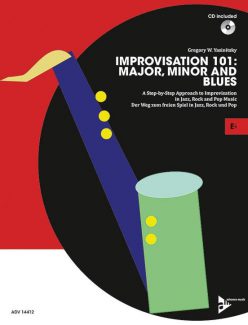It was my great pleasure to team-teach the jazz session at the 2015 American Band College with David Caffey from the University of Northern Colorado. One of the topics I covered was teaching improvisation to developing musicians.There are many, fine improvisation methods for intermediate and advanced improvisers, but materials for beginning improvisers are woefully scarce.
Over the course of thirty years, I have developed a method which works right away for developing improvisers. It is based on using notes from key centers. In other words, if the music is in the key of Bb major, notes from the Bb major scale may be used for improvising. If the music in G minor, notes from G minor scale may be used. If the music has blues harmony, blues scales may be used.When improvisers use notes derived from these key centers, the notes “fit” and sound consonant and pleasing to the ear. Because the notes sound consonant, confidence is boosted and students are then encouraged to go further with improvisation.
Most musicians—including those with limited experience playing jazz—are able to incorporate this key-center-based approach right away. It does not have a steep learning curve,A focus on key centers is particularly effective with developing improvisers.
To utilize this method with your students, you need to identify tunes which are predominantly (even exclusively) in one key.You will want to use tunes which are in major keys, minor keys and tunes which use blues harmony.
Major Keys
So that students may build skills improvising in major keys, you should find a tune in a major key with which they are familiar: Bb major is a good choice.When improvising using the notes from the Bb major scale, it is not necessary to start on Bb. Students may start on any note they want and play in any register they want.They are not limited to one octave. Students should think of the notes in the Bb major scale as a collection of pitches which they may use in any order and with any rhythms. Encourage your students to improvise with confidence.
Minor Keys
Find tunes in minor keys with which your students are familiar. D minor is be a good choice. One effective way to improvise in D minor is to use the notes from the D natural-minor scale.This is approachable by developing students because the D natural- minor scale shares the same notes with the F major scale and students are likely to be familiar with the F major scale.When improvising using the notes from the D natural- minor scale, it is not necessary to start on D. Students may start on any note they want and play in any register they want.They are not limited to one octave. Students should think of the notes in the D natural-minor scale as a collection of pitches which they may use in any order with any rhythms.When students feel comfortable improvising with the D natural-minor scale, you may encourage them to try the D harmonic-minor scale. They are likely to be less familiar with D harmonic-minor; however, there is only one note different between the D natural and harmonic-minor scales. There is a C# in the D harmonic-minor scale and a C-natural in the D natural-minor scale.Your students will find that the notes in both of these scales sound good. Encourage your students to improvise with confidence.
Blues
Find easy blues tunes in approachable keys for your students. A Bb blues is ideal. For blues tunes, students may use blues scales.The most common blues scale is constructed as follows: 1, b3, 4, #4, 5, b7 and 1, in Bb: Bb, Db, Eb, E, F,Ab, Bb.We can call this the “standard” blues scale.Another blues scale, not taught as musch, but played often by jazz musicians is structured as follows: 1, 2, b3, 3, 5, 6, 1; in Bb: Bb, C, Db, D, F, G, Bb.We may call this the “sweet” blues scale.When using these blues scales, it is not necessary to start on Bb. Students may start on any note the wish in any register they wish.They are not limited to one octave. Students should think of the notes in these blues scales as collections of pitches which they may play in any order and with any rhythms.Your students may alternate between these two blues scales whenever and wherever you like. Combining these two scales into one composite scale does not work well, though. Encourage your students to improvise with confidence.
Four Tips for New Improvisers
- Play with confidence. It is important to play jazz – and all music for that matter – with conviction. Compel the audience to listen to you, mean what you say musically and project your ideas. Since improvising is making up music as you go along, you may not be sure of what you are about to play, but you must play it as though you do know.
- Listen to jazz. It is impossible to play any kind of music without listening to it.There are certain qualities of jazz—tone quality, rhythmic interpretation, vibrato, phrasing—which can only be assimilated through careful listening. Jazz musicians learn to play by copying what they hear on recordings.
- Practice improvising. The more you practice jazz, the better you will get at it. Practice improvising in major keys, minor keys and with blues progressions. Practicing the tunes in this book will help you to build your improvisational skills.
- Learn your scales and chords. It is not necessary to know a lot about music theory to start improvising. But as you progress as a jazz player, you will want to learn more about scales and chords. Memorize scales and chords as they are introduced in this book. Then, aspire to learn more scales and chords, as many as you can.
 For more about this method, I encourage you to check out my new book, Improvisation 101: Major, Minor and Blues, which will be published by Advance Music in the coming months. It includes a step-by-step approach to mastering this method, tunes written in approachable keys, play along recordings, transcriptions of sample improvised solos and more. Also, I will be doing presentations on this method at the 2015 Jazz Education Network Conference in Louisville, KY, in January, and the Washington Music Educators Association Conference in Yakima,WA, in February.
For more about this method, I encourage you to check out my new book, Improvisation 101: Major, Minor and Blues, which will be published by Advance Music in the coming months. It includes a step-by-step approach to mastering this method, tunes written in approachable keys, play along recordings, transcriptions of sample improvised solos and more. Also, I will be doing presentations on this method at the 2015 Jazz Education Network Conference in Louisville, KY, in January, and the Washington Music Educators Association Conference in Yakima,WA, in February.
Feel free to contact me at [email protected].






